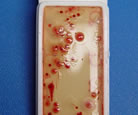Microbiological Control
 MIC (microbiologically influenced corrosion) and MID (microbiologically influenced deposits) are important considerations in all water systems including remediation systems. Many remediation systems require biological activity – however biological growth can sometimes create problems such as plugging of air strippers and biofouling of remediation recovery wells.
MIC (microbiologically influenced corrosion) and MID (microbiologically influenced deposits) are important considerations in all water systems including remediation systems. Many remediation systems require biological activity – however biological growth can sometimes create problems such as plugging of air strippers and biofouling of remediation recovery wells.
The relationships between corrosion and microbiological activity are found in many areas. Some of these include:
- Sulfate reducing bacteria
- Nitrifying bacteria
- Underdeposit Corrosion
- Differential oxygen cells due to biofilm formation
Because of these many forms of MIC it is important to consider the planktonic (free floating) forms of microbiological organism as well as the sessile (depositing) forms of bacteria.
Microbiologically Influenced Deposits (MID) may be in the form of biofilms but is often found as biomass with entrapped debris.
Biofilms also often lead to the formation of mineral scales . Calcium ions are fixed into the biofilm by the attraction of carboxylate functional groups on the outer polysaccharide layers of the biofilm. This would then provide nucleation or crystal growth sites Additionally, biofilms may entrap precipitated calcium salts and corrosion by-products from the bulk water that will act as crystal growth sites.
The use of mechanical, operational and chemical means of microbiological control are necessary to provide the most cost effective treatment programs.
The effective use of oxidizing biocides (chlorine, hypochlorite, bromine), penetrating oxidizing biocides (chlorine dioxide and ozone) and biodispersants are the technical backbone of cost effective chemical treatment for microbiological control.
Non-oxidizing biocides are effective in responding to systems that require cleanup and/or systems which have special contaminants. These biocides are targeted to specific organisms or operating conditions.

"RSC has consistently provided reliable field services and maintenance for an oxygen injection system located in Wichita, KS. These services include the purchase and installation of equipment as needed, and the completion of scheduled maintenance of our equipment on a timely basis. The end result has been increased system run time, for less cost, and a benefit to both my company and our client."
Warren French,
Project Manager/ARCADIS U.S.







